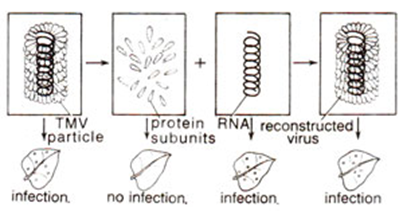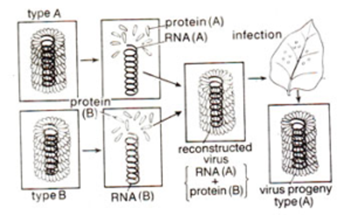Science > Biology > Gene its Nature, Expression and Regulation > Genetic Material
DNA as Genetic Material
Griffith Experiment:
Background:
Meischer isolated nuclein from nuclei of WBCs in 1869. Walter Sutton, Thomas Hunt Morgan established that the hereditary material lies in the nucleus in chromosomes. Chromosomes are formed of proteins and nucleic acid, DNA. For many years proteins were assumed to be the carrier of hereditary information due to their structural and functional diversity. By 1926 the mechanism for genetic inheritance had reached the molecular level. But exactly which molecule is responsible for heredity was not confirmed.
Bacterium Streptococcus pneumoniae occurs in two strains:
- Smooth Virulent Strain (S-III): The smooth virulent strain of Streptococcus pneumoniae is enclosed in polysaccharide capsule. Due to the presence of the capsule their colonies are smooth and shiny. Hence they are called smooth strain (S). This capsule protects them by preventing them engulfed by WBCs. As they are not destroyed by WBCs, they cause pneumonia in mice.
- Rough Avirulent Strain (R-II): The rough avirulent strain of Streptococcus pneumoniae lacks polysaccharide capsule and hence are destroyed by WBCs. Due to the absence of the capsule, their colonies have an irregular appearance. Hence they are called rough strain (R). As they are destroyed by WBCs they do not produce symptoms of pneumonia in mice.
Experiment:
In 1928 Frederick Griffith, in a series of experiments with Diplococcus pneumoniae (bacterium responsible for pneumonia), witnessed a miraculous transformation in the bacteria. During the course of his experiment, the bacteria (living organism) had changed in physical form.
The pneumococcus bacterium occurs naturally in two forms with distinctively different characteristics. The virulent or pathogenic (S-strain) form has a smooth polysaccharide capsule that is essential for infection. The nonvirulent or nonpathogenic (R-strain) lacks the polysaccharide capsule, giving it a rough appearance.
Step – 1: S-type of the pneumococcus bacteria were injected into healthy mice. The mice were infected and died from pneumonic infection within a few days,
Step – 2: R-type of the pneumococcus bacteria were injected into healthy mice. The mice were not infected and continue to live.
Step – 3: Heat Killed S-type of the pneumococcus bacteria were injected into healthy mice. The mice were not infected and continue to live.
Step – 4: A mixture of heat-killed S-type and live R-type pneumococcus bacteria were injected into healthy mice. It produced lethal results. The mice died. On observation, Griffith discovered a mixture of R-Type and living forms of the S-type bacteria in the infected dead mice.
Conclusions:
Griffith hypothesized that something has transformed the non-lethal R-type avirulent bacteria into lethal S – Type virulent bacteria. The heat-killed S-strain bacteria should be responsible for it. This transformation is called Griffith effect or bacterial transformation.
Some “transforming principle”, enabled the R-strain to synthesize a smooth polysaccharide coat and become virulent. He further observed that the “transforming principle” was transferred to the next generation. Thus “transforming principle” should be genetic material. Further, it was proved that the “transforming principle” referred to by Griffith is DNA.
Avery, Macleod and McCarty Experiment:
In 1944 Oswald Avery, Collin Macleod and Maclyn McCarty performed the same experiment as that by Griffith but their aim was definite to locate the factor responsible for a transformation of non-lethal R-type bacteria into lethal S – Type bacteria. They used a test tube assay instead of mice.
They purified DNA, RNA, proteins and other materials from heat-killed S – type bacteria using corresponding dissolving enzymes. Then they mixed purified content with R – type to see which one could transform living R – type into S – type.
Only those mixed with DNA were transformed into S – type bacteria. When DNA was treated with Deoxyribonuclease, the DNA was digested and dissolved, there was no transformation of R-type bacteria into S – Type bacteria. This confirmed that “transforming principle” is DNA. But scientist community at that time was not convinced.
Hershey – Chase Experiment:
Alfred Hershey and Martha Chase (1952) experimentally proved that DNA is the only genetic material. They worked with viruses that infect bacteria called bacteriophages (T2-phages).
The bacteriophage attaches by its tail to the bacteria and its genetic material then enters the bacterial cell and protein coat is left outside. The bacterial cell treats the viral genetic material as if it was its own and subsequently produces more virus particles. A large number of phage-DNA molecules are formed. Each of these DNA molecules develops its own protein coat forming daughter phage particles.
Hershey and Chase performed an experiment to discover whether it was protein or DNA from the viruses that entered the bacteria.
Step – 1:
They used the fact that DNA contains phosphorus but not sulphur, while protein contains sulphur but not phosphorous. They grew some viruses on a medium that contained radioactive phosphorus (32P) and some others on the medium that contained radioactive sulphur (35S).
Observations: Viruses grown in the presence of radioactive phosphorus contained radioactive DNA but not radioactive protein. Similarly, viruses grown on radioactive sulphur contained radioactive protein but not radioactive DNA.
Step – 2:
Radioactive phages were allowed to attach to E. coli bacteria. As the infection proceeded, the viral coats were removed from the bacteria by agitating them in a blender and the virus particles were separated from the bacteria by spinning them in a centrifuge.
Observations:
Bacteria which was infected with viruses that had radioactive DNA were radioactive, indicating that DNA was the material that passed from the virus to the bacteria. The phages grown in radioactive phosphorous passed their radioactivity to the daughter phage particles through DNA.
Bacteria that were infected with viruses that had radioactive proteins were not radioactive. The phages grown in radioactive sulphur did not pass their radioactivity to the daughter phage particles through proteins. This indicates that proteins did not enter the bacteria from the viruses.
Conclusion:
Therefore DNA is the genetic material that is passed from virus to bacteria.
RNA as Genetic Material
Frankel-Conrat and Singer Experiment:
H. Frankel-Conrat and B. Singer (1957) performed an experiment with tobacco mosaic virus (TMV) and demonstrated that in some cases RNA acts as a genetic material.
Tobacco mosaic virus (TMV) does not contain any DNA. It consists of RNA surrounded by a hollow cylinder of protein subunits. They found that the virus could be broken into component parts and they could again be reassembled or reconstituted to form a functional virus.

Viruses with the single-stranded genome (RNA) use a single strand as a template and synthesize a complementary single strand of DNA. This complementary single-strand DNA, in turn, synthesize its complementary strand and forms a double-stranded DNA.
Techniques were first developed for separating TMV particles into RNA and proteins. Later by using RNA and proteins separately in tests for infectivity, it could be shown that RNA alone was able to cause infection. Such property was not found in the protein fraction.
When the cell debris (protein coat) of the virus was introduced into tobacco leaf, the leaf remained healthy. When the cell filtrate (nucleic acid) was injected into tobacco leaf, it was infected with the virus and died. This shows that the RNA is causing the infection and not the protein.
The progeny viruses produced were always found to be phenotypically and genotypically identical to the parent strain from which the RNA had been obtained.
In one experiment, two viruses used were tobacco mosaic virus (TMV) and Holmes rib-grass virus (HRV). Reciprocal hybrid using RNA of one strain and protein of the other strain is obtained. It was found that when these hybrids were used for infection, the progeny had proteins which corresponded to the virus from which RNA of the infecting virus particles was derived.

Properties of DNA in Genetic Material:
- DNA has the ability to store hereditary information in coded form.
- DNA is present in all the cells of the organism.
- DNA shows diversity corresponding to the varieties existing in the organisms.
- DNA has the capacity to replicate itself to produce a carbon copy that could be transferred to daughter cells (successive generations).
- DNA is able to express itself through specific biological molecules like proteins and enzymes.
- DNA has physical and chemical stability so that the stored information is not lost.
- DNA (genes) is capable of differential expression so that the various parts of an organism may acquire specific form, structure and functions in-spite of having the same genetic material.
- DNA (genes) undergoes gradual mutations and recombinations so that the new characters appear in the organism to produce diversity.
Comparision Between DNA and RNA as Genetic Material:
- DNA is the genetic material in most organisms except in plant viruses and some animal viruses where RNA acts as genetic material.
- Both have a stable structure and yet capable of undergoing mutations (slow changes).
- Both are capable of transcription and translation.
- As both DNA and RNA follow base pair-rule and hence exhibit complementarity. Both of them have the ability to direct their duplication.
- DNA is very stable while RNA is more reactive (less stable).
- RNA mutates faster than DNA
- RNA can code for the synthesis of protein directly while DNA depends on RNA to transfer the message of protein synthesis from the nucleus into the cytoplasm.
- From the above points, we can conclude that DNA is more stable. Hence are more suited for storing genetic information.